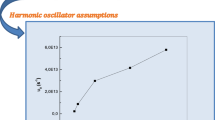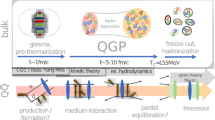Abstract
We establish the Lee–Huang–Yang formula for the ground state energy of a dilute Bose gas for a broad class of repulsive pair-interactions in 3D as a lower bound. Our result is valid in an appropriate parameter regime of soft potentials and confirms that the Bogoliubov approximation captures the right second-order correction to the ground state energy.
Similar content being viewed by others
Notes
Note that we allow but not require R to be smaller than \(\rho ^{-1/3}\).
References
Aaen, A.: The ground state energy of a dilute Bose gas in dimension \(n >3\). arXiv:1401.5960 (2014)
Boccato, C., Brennecke, C., Cenatiempo, S., Schlein, B.: Bogoliubov theory in the Gross–Pitaevskii limit. Acta Math. 222(2), 219–335 (2019), arXiv:1801.01389 (2018)
Boccato, C., Brennecke, C., Cenatiempo, S., Schlein, B.: Complete Bose–Einstein condensation in the Gross–Pitaevskii regime. Commun. Math. Phys. 359, 975–1026 (2018), arXiv:1703.04452 (2017)
Boccato, C., Brennecke, C., Cenatiempo, S., Schlein, B.: Optimal rate for Bose–Einstein condensation in the Gross–Pitaevskii regime. Commun. Math. Phys. (2019), arXiv:1812.03086 (2018)
Boccato, C., Brennecke, C., Cenatiempo, S., Schlein, B.: The excitation spectrum of Bose gases interacting through singular potentials (to appear on J. Eur. Math. Soc.), arXiv:1704.04819 (2017)
Bogoliubov, N.N.: On the theory of superfluidity. Proc. Inst. Math. Kiev 9, 89–103 (1947). Eng. Trans. J. Phys. (USSR), 11, 23 (1947). Rus. Trans. Izv. Akad. Nauk USSR, 11, 77–90 (1947). See also Lectures on Quantum Statistics, Gordon and Breach (1968)
Brietzke, B.: On the Second Order Correction to the Ground State Energy of the Dilute Bose Gas, PhD Thesis (2017)
Brietzke, B., Fournais, S., Solovej, J. P.: A simple 2nd order lower bound to the energy of dilute Bose gases. arXiv:1901.00539 (2019)
Conlon, J.G., Lieb, E.H., Yau, H.-T.: The \(N^{7/5}\) law for charged bosons. Commun. Math. Phys. 116, 417–448 (1988)
Dyson, F.J.: Ground-state energy of a hard-sphere gas. J. Math. Phys. 106, 20–26 (1957)
Erdős, L., Schlein, B., Yau, H.-T.: Ground state energy of a low-density Bose gas: a second-order upper bound. Phys. Rev. A 78(5), 053627 (2008)
Foldy, L. L.: Charged Boson gas. Phys. Rev. 124, 649-651 (1961). Errata ibid125, 2208 (1962)
Fournais, S., Solovej, J. P.: The energy of dilute Bose gases. arXiv:1904.06164 (2019)
Girardeau, M., Arnowitt, R.: Theory of many-Boson systems: pair theory. Phys. Rev. 113, 755–761 (1959)
Giuliani, A., Seiringer, R.: The ground state energy of the weakly interacting Bose gas at high density. J. Stat. Phys. 135, 915–934 (2009). arXiv:0811.1166 (2008)
Lee, T.D., Huang, K., Yang, C.N.: Eigenvalues and eigenfunctions of a Bose system of hard spheres and its low-temperature properties. Phys. Rev. 106, 1135–1145 (1957)
Lenz, W.: Die Wellenfunktion und Geschwindigkeitsverteilung des entarteten Gases. Z. Phys. 56, 778–789 (1929)
Lieb, E.H.: The Bose Fluid. In: Brittin, W.E. (ed.) Lecture Notes in Theoretical Physics VIIC, pp. 175–224. University of Colorado Press, Boulder (1964)
Lieb, E.H.: Simplified approach to the ground-state energy of an imperfect Bose gas. Phys. Rev. 130, 2518–2528 (1963)
Lieb, E.H., Liniger, W.: Exact analysis of an interacting Bose gas. I. The general solution and the ground state. Phys. Rev. 130, 1605–1616 (1963)
Lieb, E.H., Loss, M.: Analysis. American Mathematical Society, Providence (2001)
Lieb, E. H., Solovej, J. P.: Ground state energy of the one-component charged Bose gas. Commun. Math. Phys. 217, 127–163 (2001). Ibid Erratum 225, 219–221 (2002), arXiv:cond-mat/0007425 (2000)
Lieb, E. H., Solovej, J. P.: Ground state energy of the two-component charged Bose gas. Commun. Math. Phys. 252, 485–534 (2004), arXiv:math-ph/0311010 (2003)
Lieb, E.H., Seiringer, R., Solovej, J.P., Yngvason, J.: The Mathematics of the Bose Gas and Its Condensation. Birkhäuser, Berlin (2005)
Lieb, E.H., Yngvason, J.: Ground state energy of the low density Bose gas. Phys. Rev. Lett. 80, 2504–2507 (1998)
Napiórkowski, N., Reuvers, R., Solovej, J.P.: The Bogoliubov free energy functional II: The dilute limit. Commun. Math. Phys. 360, 347–403 (2017)
Robinson, D.W.: The Thermodynamic Pressure in Quantum Statistical Mechanics. Lecture Notes in Physics, vol. 9. Springer, Berlin (1971)
Yau, H.-T., Yin, J.: The second order upper bound for the ground energy of a Bose gas. J. Stat. Phys. 136, 453–503 (2009). arXiv:0903.5347
Acknowledgements
This project started out many years ago from a fruitful discussion with E. H. Lieb, who the authors are very grateful to. This work was primarily done in Copenhagen and the authors acknowledge support by ERC Advanced grant 321029 and by VILLUM FONDEN via the QMATH Centre of Excellence (Grant No. 10059). BB also gratefully acknowledges support from the DFG (Grant No. AOBJ 643360 KN 102013-1) and under Germany’s Excellence Strategy EXC-2181/1 – 390900948.
Author information
Authors and Affiliations
Corresponding author
Additional information
Communicated by Jan Derezinski.
Publisher's Note
Springer Nature remains neutral with regard to jurisdictional claims in published maps and institutional affiliations.
Appendix A: Taylor Expansions for the Bogoliubov Integral
Appendix A: Taylor Expansions for the Bogoliubov Integral
The quadratic Hamiltonian and thus the integral \(\int h_0(k) \, {\mathrm {d}}k\) (see Lemma 4.4) plays an important role in this article. In this appendix, we will estimate this integral using Taylor approximations to various order on different regions. The resulting estimates are given in a general form as powers in n. This allows us in several lemmas to obtain bounds on the energy from bounds on n, respectively, to obtain bounds on n for states which have sufficiently low energy.
Throughout this appendix we will assume that \(n\ge 1\) and that the condition on \(n|{B} |^{-1}\) in Lemma 4.6 is satisfied, so that by Lemma 4.4 we have the lower bounds
and
1.1 A.1. Bounds for the Quadratic Part of \(H_B\)
We estimate the operator-valued integral \(\frac{1}{2}(2\pi )^{-3}\int h_0(k)\, {\mathrm {d}}k\) using the following facts.
Around \(x=0\) we can write \(\sqrt{1+x}=1+\frac{1}{2}x-\frac{1}{8}x^2+\frac{1}{16}x^3+O(x^4)\) yielding the bounds
If B is either a small or a large box, then, for all \(k\in {\mathbb {R}}^3\), the parentheses in (A.1) is positive.
This is easy to see. If B is a small box and \(|{k} |\le (ds\ell )^{-1}\), then \(\tau _B(k^2)=0\) and \(\widehat{W}(k)>0\) by (104) since \((ds\ell )^{-1}<R^{-1}\). For \(|{k} |>(ds\ell )^{-1}\) we have \(\tau _B(k^2)>0\) and apply (A.4). For the large box the claim is proven analogously. We may therefore replace \(n_0\) by n in (A.1) when bounding \(h_0\) from below such that
Provided \(\tau _B(k^2)>0\), we write
1.1.1 A.1.1. Estimates on the Small Box
\(\tau _B(k^2)=0\) if \(|{k} |<(ds\ell )^{-1}\) while \(\widehat{W}(k)>0\) if \(|{k} |<R^{-1}\). Since \(\sqrt{1+x}\ge 1\) if \(x\ge 0\), we have
Using (A.3) for \(2(ds\ell )^{-1}<|{k} |<R^{-1}\) and (A.4) for \(|{k} |>R^{-1}\) gives
Since \(\tau _B=(1-\varepsilon _0)[|{k} |-(ds\ell )^{-1}]_+^2\ge C|{k} |^2\) if \(|{k} |\ge 2(ds\ell )^{-1}\) and we have \(|{\widehat{W}(k)} |\le \widehat{W}(0)\le Ca\), it is easy to estimate the last term in (A.8)
The integral \(\int _{{|{k} |>2(ds\ell )^{-1}}}^{{}}\frac{\widehat{W}(k)^2}{\tau _B(k^2)}\, {\mathrm {d}}k\) is related to the second Born term, and we have to estimate it carefully. Recall that on the small box we have by (31) that \(v_R(x)\le W(x)\le v_R(x)(1+C(\frac{R}{d\ell })^2)\). Thus we have
Since \(v_R(x)=\frac{1}{R^3} v_{1}(\frac{x}{R})\), we have \(\widehat{v_R}(k)=\widehat{v_{1}}(Rk)\) and that
For \(f\in L^{\frac{6}{5}}({\mathbb {R}}^{3})\) a real space representation (see [21] Cor 5.10) followed by an application of the Hardy–Littlewood–Sobolev inequality gives
On the small box, we have for \(|{k} |>2(ds\ell )^{-1}\)
We use a Cauchy–Schwarz inequality, (A.10) and (A.12) to obtain the estimate
Using \(|{\widehat{W}(k)} |\le Ca\), gives
Combining (A.13), (A.14) and (A.15), we arrive at
In the last inequality, we used that the second term in (A.14) and the positive term \((1+C\varepsilon _0)\frac{1}{R}\int _{{|{k} |<2(ds\ell )^{-1}R}}^{{}}\frac{\widehat{v}_{1}(k)^2}{|{k} |^2}\, {\mathrm {d}}k\) by Condition 1 are bounded by the last term in (A.16).
1.1.2 A.1.2. Estimates on the Large Box
Recall that on the large box, we have \({\int \chi _B^2=|{B} |}\) and that
Hence, as in (A.7),
Analogously to (A.8), we have
The last term in (A.18) is estimated in the same way as the last term in (A.8)
By (30), we have \(v_R(x)\!\le \! W(x)\!\le \! v_R(x)(1\!+\!C(\!\frac{R}{\ell })^2)\!\). Thus, similarly to (A.14),
Similarly to (A.15), we have
Since
we have, similar to (A.16),
In the last inequality, we used that by Condition 1 the terms \(C\frac{aR}{\ell ^2}a\) and \(\int _{{|{k} |<(s\ell )^{-1}}}^{{}}\,\frac{\widehat{v}_{R}(k)^2}{|{k} |^2}\, {\mathrm {d}}k\) are bounded by the second to last term in (A.23).
Rights and permissions
About this article
Cite this article
Brietzke, B., Solovej, J.P. The Second-Order Correction to the Ground State Energy of the Dilute Bose Gas. Ann. Henri Poincaré 21, 571–626 (2020). https://doi.org/10.1007/s00023-019-00875-3
Received:
Accepted:
Published:
Issue Date:
DOI: https://doi.org/10.1007/s00023-019-00875-3




